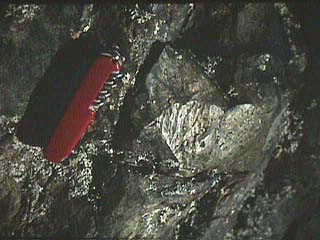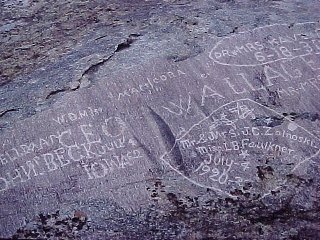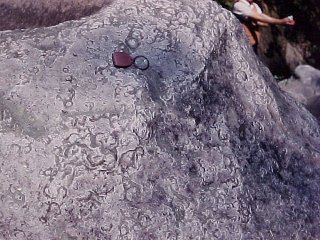Leaverites - Surface Markings
Steven Dutch, Professor Emeritus, Natural and Applied Sciences, University of Wisconsin - Green Bay
Dirt
Believe it or not, many people don't realize they have to clean the dirt off a rock to tell what it is. So give any unusual rock a good scrubbing first. That odd marking may just be stuck-on soil.
Burial
If the rock was partially buried, half of it will be clean and the other half covered with dirt. If the rock has a sharp boundary and one half looks dirty or earthy, this may be why. Scrub the soil off.
Moss, Lichens, and Micro-organisms
| Crusty stuff on a rock is probably lichens and even a wire brush won't remove it. Some lichens are brilliantly colored red or yellow. Green stains on or within a rock, especially in damp settings, are often algae, not a mineral. Black stains may be organic carbon or micro-organisms, too. |  |
Water Markings
| Rocks that have been half immersed in water may have a line around the rock marking the water line. The line may be accented by white powdery films, which may be due to suspended mud or dried algae. Yellow powder may be pollen, which floats on the surface of the water. |  |
 |
The rock shown here has a band of iron oxide marking where it was either immersed in water or half buried. |
Precipitates and Surface Films
| Lots of rocks are covered with thin films of material leached out of other rocks or soil. The orange is a thin film of iron oxide. The black is iron or manganese oxide. The rock itself is white. |  |
 |
This rhyolite pebble has a surface coating of calcium carbonate leached out of the surrounding materials. |
| This dolomite pebble, from the same glacial deposit as the rock above, also has a surface coating of calcium carbonate. Pock marks indicate where other pebbles stuck to the rock. This is the first step in cementing the gravel together to form conglomerate. |  |
Iron Oxide
Red, orange, or brown coloring is often due to iron oxide. The iron oxide is usually derived from weathering of other minerals or man-made objects.
Sulfur
Sulfide minerals weather and often liberate free sulfur, which creates a yellowish-green coating. It may well be accompanied by a sulfur smell and iron oxide stains.
Swirly Layers
| Layers in a rock may look very convoluted from some angles because of the irregular surface. Turn the rock and see if the layers look flat from a different viewing angle. |  |
| The same rock as above, seen from the side. The layers are perfectly flat. |  |
 |
The apparently concentric layers in this rock (accented by an accidental spray painting) are actually perfectly flat when viewed from the side. |
| Contortions like these are often due to burrowing organisms. Disturbance by organisms is called bioturbation. |  |
 |
These concentric layers are an actual fossil, a mound-shaped colony of algae called a stromatolite. |
Liesgang Rings
| These are swirly red or brown bands in rock created by iron oxide solutions moving through the rocks. They may just be surface features on fracture surfaces or they may extend into the interior of the rock.
These are in sandstone and probably extend into the rock. |
 |
 |
These swirls are on a fracture surface in quartzite and are purely surficial. |
Tarnish
Metallic minerals often develop a tarnish. It may be multi-colored (iridescent) or just dull. Often fracture surfaces within rocks have thin films of dissolved minerals on them.
Wind Abrasion
| Stones polished by wind abrasion are called ventifacts. Often they develop flat faces with fluting and sharp but low-angle ridges between the faces. Stones faceted on several faces are called dreikanters, from a South African word meaning "three corners."
You don't have to go to deserts to find ventifacts. The retreat of the glaciers provided ideal conditions for wind abrasion all across North America. This perfect dreikanter was found in River Falls, Wisconsin. |
 |
 |
Similar textures can occur on solid rock outcrops. This example is from Butler Rock in northern Wisconsin. |
| The top of Independence Rock, Wyoming is famous for its inscriptions left by pioneers on the Oregon Trail. The best ones are found in areas with high polish, gentle fluting, and occasional deep, sharp edged troughs. Neither running water nor glaciers could have created these surfaces; the only remaining possibility is wind. |  |
Water Abrasion
| Smoothing and sculpting by running water is common, but a high degree of polish like this is relatively uncommon. |  |
 |
Rocks battered by large debris during floods can develop circular percussion marks like these. |
| A classical optical illusion. These are gentle, concave hollows, not bumps. The light is coming from the top in this picture. Water-abraded surfaces often develop this pattern of gentle hollows separated by sharp ridges. In places where both water and wind may have been active, it can be hard to tell what specifically formed the surface texture. |  |
 |
Fast-moving water can swirl debris around in depressions to erode potholes. Some can be very large and deep. |
Glacial Markings
| A wide variety of features caused by glacial action. Most commonly the rock is smoothly planed off. It may even have a shiny polish and usually shows scratches or striations that indicate the ice movement direction. At right is a fragment of a glacially polished and striated outcrop. |  |
 |
This is a striated cobble. This is a pebble that was either frozen in the ice and scraped over the bedrock, or frozen in the ground beneath the glacier and planed off by erosion. |
Slickensides
| Thin films of smeared-out minerals, usually with a grooved or linear texture, caused by fault movement. It need not be a major fault; slip of a few inches can do it. |  |
Weathering Rinds
| Weathering often affects only the surface of a rock and a cross-section will expose a very different material inside. |  |
 |
Return to Mineralogy-Petrology Index
Return to Thin-Section Index
Return to Crystals and Light Index
Return to Crystal Structures Index
Return to Mineral Identification Tables
Return to Professor Dutch's Home Page
Created 15 October 2009, Last Update